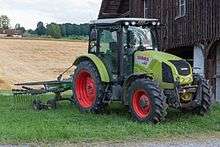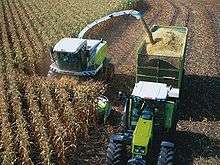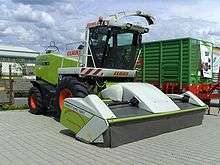Claas
|
| |
| GmbH & Co. KGaA | |
| Industry | Agricultural machinery, Agriculture |
| Founded | 1913 |
| Headquarters | Harsewinkel, Germany |
Key people | Strategy and Corporate Communications, speaker of the executive board |
| Revenue |
|
Number of employees | 11,535 (2015) |
| Website | www.claas.com |





Claas is an agricultural machinery manufacturer founded in 1913, based in Harsewinkel, Ostwestfalen-Lippe, Germany, in the state of North Rhine Westphalia. The product range includes combine harvesters, forage harvesters, balers, mowers, rakes, tractors, tedders and other harvesting machines. Claas is believed to be the top combine harvester manufacturer in the world, producing its 450,000th machine in 2013. Claas is the world leader in rubber tracked wheel technology for combine harvesters. Over 45% of all new combines are equipped with rubber tracks. Claas also has the largest selling self-propelled forage harvester in the world and manufactures a full line of tractors. .
CLAAS offers a choice of 34 models between 72 and 524 hp: the XERION 4x4 high-horsepower tractors, the AXION, ARION and ATOS standard tractors, the compact ELIOS class and the NEXOS models in the narrow gauge range. This extensive and impressive portfolio is specifically designed to meet the needs of modern agriculture. [2]
History
The start of the Claas group took place in 1913[3] when August Claas, developed the company in Clarholz, Germany. In 1919, the business was transferred to Harsewinkel, Germany, where the company focused on the production of reapers. Two years later the company obtained their first patent – for a knotter to efficiently bind straw. In 1930, the first Harvester was developed with the European market in mind with the first Pick-up Baler following in 1934. In 1936 Claas started to market the first combine harvester built in Europe, as opposed to imported machines previously available. They then offered trailed combine harvesters (reaper-binders) to the European market.
In 1946, following the war, Claas introduced self-propelled combine harvesters. By the mid 1950s they opened a new factory in Paderborn, Germany, and their first outside Germany – in Metz, France in 1961. Claas took over Josef Bautz, (agricultural machinery factory) in 1969 and expanded the product range to include green harvest machinery.
Modern era 1970s
- 1971 Development of a pick-up sugar cane harvester
- 1973 Presentation of the first self- propelled forage harvester
- 1976 Introduction of the first Claas round baler ROLLANT
- 1983 Introduction of JAGUAR self-propelled forage harvesters
- 1988 Claas presents QUADRANT, the first Claas large-square baler
- 1994 Start of development of Agrocom, a computer based, satellite-assisted, agricultural information system
- 1995 Claas, in a joint partnership with Caterpillar introduces the LEXION combine, the most powerful combine in the world (up to 40 tonnes of grain per hour).
Since 2000
- 2001 Claas Omaha (COL) opened in 2001 and starts to produce the LEXION combine series. Caterpillar sells its 50% stake in the venture to Claas.[4] North American LEXION combines continue to be distributed by Caterpillar dealers.
- 2003 Claas acquires a majority stake in Renault Agriculture and expands its product range with tractors and the 400,000th combine harvester, a LEXION 480, is produced.
- 2004 The 20,000th Jaguar Forage Harvester commemorated with a special coat of paint and the 1000th tractor are produced.
- 2005 Claas opens a new factory in Krasnodar in South Russia. Launch of LEXION 600 Combine.
- 2006 Claas manufactures the 80,000th ROLLANT baler, and launch of the AXION tractor.
- 2007 Claas launches TUCANO combine, larger JAGUAR from 630 hp - 830 hp, ARION tractor 112 hp- 175 hp and larger XERION 379 hp.
- 2008 Claas acquires the remaining stake of Renault Agriculture to make it 100% Claas owned. The AXOS tractor, up to 100HP, is unveiled.
- 2009 The AVERO, a compact-class combine harvester is introduced. The XERION 5000 is released which features more than 500HP.
- 2010 The 1000th XERION tractor rolls of the line and features a special coat of white paint. A new technology center opens up in Harsewinkel.
- 2011 The AXION 900 is presented at the SIMA show in Paris, France. The 30,000th Jaguar is produced and receives a special coat of paint. The LEXION 770, the world's only class 10 combine harvester at the time, sets a Guinness World Record with 675.84 tons of grain harvested in 8 hours.[5]
- 2013 Claas produces its 450,000th combine, a LEXION 740 Terra Trac, at Claas of America's La Vista, Nebraska assembly plant.[6]
- 2013 Claas introduces the all new AXION 800 series. At the end of the year the AXION 850 wins tractor and machine of the year 2014 at the Agritechnica show in Germany.
Claas Museum
The Claas Museum is located in the Claas Technoparc in Harsewinkel, Germany, and features a display of historical harvesting machines and agriculture equipment. Visitation is during working days only.
References
- ↑ "Annual Report - Statistics". CLAAS Group. Retrieved 1 November 2016.
- ↑ http://www.claas.fi/products/tractors
- ↑ http://www.claas-group.com/cc/servlet/generator/cl-gr/en/company/history/milestones/start,bpSite=35108.html
- ↑ Henderson, Lynn. "CLAAS: The Harvesting Specialists". AgriMarketing.com. Retrieved 13 October 2013.
- ↑ "Combine Harvesting (Wheat) - Team in Eight Hours". Guinness World Records. Guinness World Records. Retrieved 10 August 2013.
- ↑ Nohr, Emily. "CLAAS celebrates milestone with combine 'masterpiece'". Omaha World-Herald. Retrieved 13 October 2013.
External links
![]() Media related to Claas at Wikimedia Commons
Media related to Claas at Wikimedia Commons